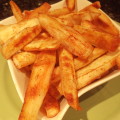
It’s that time of year again where the markets are overflowing with fall harvests! What better time of year to enjoy squashes than now?!
Here’s my personal opinion and run down on some of the most popular squashes:
1. Summer squash: lovely, but it’s the end of the season, really, so, forget yellow squash and zucchini for now!
2. Delicata squash: oh yes, these can be eaten with the skin on. They are wonderful to use as “containers.” Clean, halve, de-seed, and roast, boil or steam. Then fill with a nice stuffing of your choice and serve! The pretty multi-colored skin does a wonderful job with presentation.
3. Acorn squash: this one gets the most uses during Thanksgiving and winter holidays. Why? It is adorable, cute, and festive looking. Clean, de-seed, halve, add some tasty sweetener before or after, then roast, bake, or steam. However, note that this squash is probably the least flavorful. Without seasoning, I wouldn’t appreciate this one very much! Still, nice presentation if you season it properly.
4. Butternut: probably the best all-around squash for everything under the kitchen ceiling. It’s great for making a pureed soup, just a bit of seasoning will complement the rich flavor of this squash (especially after roasting). Very simple dishes can be made simply by roasting and cutting, with a bit of seasoning, or roasting and mashing. Another nice way to prepare this is to chop it and place it in soups or in curry dishes. Like with other squashes, this is an excellent choice to use in presentations when stuffing the nicely shaped squash. This an also be used in place of pumpkin for some baked goods, like muffins, or in pancakes.
5. Pumpkin (sugar/pie pumpkins): as we all love and know this squash so well, it’s favorite use is for pie! Also good when used in muffins, cookies, pancakes, cakes, and puddings. Can be made into soup or used in curries or stews. Wonderful when fresh, but pretty decent from a can. Be careful when choosing canned pumpkin for savory items: choose the unsweetened not the pie mix.
6. Kabocha: Japanese for “pumpkin.” This squash can also be eaten with the skin on. However, unlike delicata, this one is much more flavorful. Some chefs even use this in place of regular pie pumpkins for pumpkin pie and other baked goods: I would recommend this too if you can’t find pie pumpkins or you prefer Kabocha (I do!). This is also great in stir fry (slice thinly), curries, stews, soups, and as a stand-alone dish (a warm “salad” of roasted kabocha, yum! how about mashed kabocha? also tasty!) with minimal seasoning. The soft, velvety texture and edible skin makes this my favorite squash. But, you may wish to peel off certain areas that aren’t smooth, as that texture is undesirable for consumption.
7. Spaghetti squash: this is a fun one to cook with because the interior ‘breaks up’ into strands, hence the name. This can be used to make a wonderful base for any sauce. The squash itself has little flavor that would detract from a tasty sauce, so no worries for conflicting flavors. Some use this instead of grain noodles for pasta dishes. It can also be added to soups, stews, and curries.
8. Hubbard squash: treat this one like sugar pie pumpkin squash. The skin should be removed. However, it is hard to remove, so it’s not a favorite choice of this author. The squash is rather tasty, though, and can be used for anything that pie pumpkins are used for, including savory dishes.
9. Carnival squash: This one reminds me of delicata squash, but more difficult to prepare. The skin should be removed, which has deep grooves. However, if you’re roasting it, it’s a pretty good choice and looks lovely for presentation with the multi-colored skin. My suggestion would be to avoid peeling, and just roast and stuff!
10. Buttercup and autumn cup: these are pretty similar, the autumn cup being related to the buttercup and kabocha. Both buttercup and autumn cup need to be skinned, or just roasted. The flesh varies in color from yellow (autumn cup) to orange (buttercup). They are both rich in flavor. Think of using them as you would kabocha or pie pumpkin. Again, my concerns are always whether the squash needs to be chopped and peeled or just roasted/steamed. If chopping and peeling, these probably will be tough to manage. Consider roasting instead and scooping/cutting afterwards!
11. Turban squash: oh are these hard to cut! As with some other squashes, I’d recommend roasting them, then cutting down to size or scooping out. Nice choice to use for sweet dishes that require pureed squash. Also very nice decoration for a short while before being used.
12. Sweet dumpling squash: as a personal preference, I’d recommend this over acorn squash. Wherever acorn squash can be used, this one is a better choice because it’s sweeter, requiring less additional sugar and seasoning. I prefer having the squash do the flavoring itself. They are good for individual servings, like the acorn squash, when cut in half and roasted. Nice presentation too with the multi-colored skin. Like a turban squash, decorative until used!
This list is by no means comprehensive, but certainly covers a handful of squashes we all know and love! Happy squash cooking, baking, roasting, mashing, pureeing, sauteing, and most importantly, eating!






1 Comment
Chia (324 comments)
November 23, 2009 at 8:36 pmThat’s a beautiful image and a reminder of the amazing fall squash harvest. Thanks!